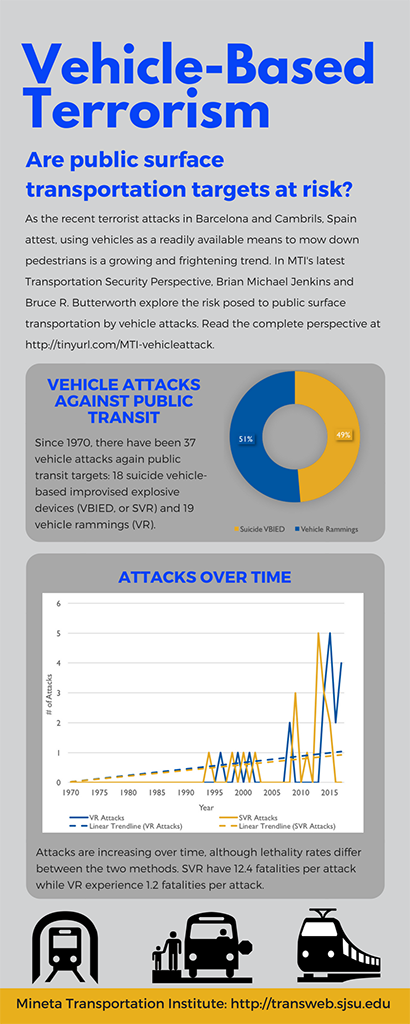- 408-924-7560
- mineta-institute@sjsu.edu
- Donate
Vehicle-based Terrorism
As the recent terrorist attacks in Barcelona and Cambrils, Spain attest, using vehicles as a readily available means to mow down pedestrians is a growing and frightening trend. In the Mineta Transportation Institute’s latest Transportation Security Perspective, Brian Michael Jenkins and Bruce R. Butterworth explore the risk posed to public surface transportation by vehicle attacks.
 Since January 2015, there have been ten such vehicular assaults. Prior to the attacks in Spain, similar assaults occurred in France, Germany, Sweden, Austria, Belgium, Israel, the Palestinian territories, the United Kingdom, and the United States. This type of vehicular assault can occur at public surface transportation locations such as bus stops or train stations. However, the data suggests that, so far, vehicle rammings are not as lethal as might be thought, and have not been used as often as one might expect against public transportation targets.
Since January 2015, there have been ten such vehicular assaults. Prior to the attacks in Spain, similar assaults occurred in France, Germany, Sweden, Austria, Belgium, Israel, the Palestinian territories, the United Kingdom, and the United States. This type of vehicular assault can occur at public surface transportation locations such as bus stops or train stations. However, the data suggests that, so far, vehicle rammings are not as lethal as might be thought, and have not been used as often as one might expect against public transportation targets.
Since January 1970, there have been 37 vehicle attacks on public surface transportation. Just under half, a total of 18, involved suicide drivers ramming vehicles packed with explosives into their targets – a more complex operation to pull off. In the other cases, the vehicle itself was the weapon.
Although recently on an upward trend, the 37 vehicle attacks on surface transportation targets represent less than one percent of the total number of 5,275 attacks on surface transportation targets during 1970. The 18 suicide vehicle rammings (SVR) and 19 vehicle rammings (VR) resulted in a total of 247 fatalities, which represents about two percent of all fatalities caused by attacks on surface transportation during the same period. All but 24 of the fatalities resulted from the attacks with explosives. In addition to the deaths, the 37 attacks caused 594 injuries.
Overall, the number of attacks of both types is increasing and follow a similar trend. For VR, 14 of the 19 attacks occurred between 2014 and 2017. For SVR, 10 of the 18 attacks occurred between 2013 and 2015 (with none in 2016 and, so far, none in 2017).
However, in terms of lethality, the two attack methods differ. SVR account for 90 percent of the 247 fatalities, with an average fatalities per attack (FPA) of 12.4. This makes SVR the second most lethal terrorist attack method against public surface transportation. Only multiple weapon attacks involving train derailments are more lethal. VR, by contrast, are the 21st most lethal tactic, with an average FPA of 1.3, considerably lower than the average for all attacks on surface transportation.
Vehicle rammings, with or without explosives, directed against public surface transportation targets are, of course, a concern that attracts a great deal of public attention. But so far, they have occurred rarely and mainly in countries alreadyexperiencing on-going insurgencies or terrorist campaigns. And although the number of vehicle attacks has increased, with 19 of the 37 attacks occurring since 2014, and the lethality of the two attack methods combined has also increased, the increase is not particularly dramatic.
The most recent vehicle ramming attacks, however, have been directed primarily against pedestrians, not necessarily transportation targets. Governmental and transportation authorities will need to continue to assess these attack methods and consider what countermeasures (such as, but not limited to, bollards) can be reasonable and effective.
The report is available for free download from http://transweb.sjsu.edu/PDFs/research/terrorist-vehicle-attacks-on-public-surfacetransportation-targets.pdf.
ABOUT THE AUTHORS
Brian Michael Jenkins is the director of the Mineta Transportation Institute’s National Transportation Safety and Security Center and since 1997 has directed the Institute’s continuing research on protecting surface transportation against terrorism and other serious forms of crime. Bruce R. Butterworth is a Mineta Research Associate and former Director of Aviation Security Operations at the Federal Aviation Administration.
ABOUT THE MINETA TRANSPORTATION INSTITUTE
At the Mineta Transportation Institute (MTI) at San Jose State University (SJSU) our mission is to increase mobility for all by improving the safety, efficiency, accessibility, and convenience of our nation's’ transportation system through research, education, workforce development and technology transfer. We help create a connected world. MTI was founded in 1991 and is funded through the US Departments of Transportation and Homeland Security, the California Department of Transportation, and public and private grants. MTI is affiliated with SJSU’s Lucas College and Graduate School of Business.
###
Contact:
Hilary Nixon, Ph.D.
MTI Director of Research and Technology Transfer
408.924.7564
hilary.nixon@sjsu.edu
-
Contact Us
San José State University One Washington Square, San Jose, CA 95192 Phone: 408-924-7560 Email: mineta-institute@sjsu.edu





